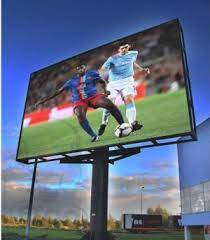Let’s consider the standard characteristics of the screen indoors and outdoors, regardless of the type of metal structure and installation. As a measure, let’s take an LED screen with an area of 1 square meter. The main characteristics are:
Pixel pitch
This parameter determines the overall screen resolution and comfortable viewing distance: For outdoors – from 5 to 10 mm for indoors – from 1 to 10 mm
For example, a screen measuring 1 x 1 m with a pitch of 5 mm will have a resolution of 500 x 500.
LED manufacturer and chip (SMD screen marking)
For example, the marking Epi-star 3535 SMD (3in1) is the manufacturer Epi-star, 3535 is the chip size nm, and SMD (3in1) is the type of diode.
Screen brightness
This characteristic is determined by the conditions for placing the SMD screen and its subsequent task.
Street – from 5500 to 7000 cd
Room – from 1500 to 2500 cd
Viewing angles – this characteristic is standard on all SMD screens and is indicated horizontally and vertically, 120 /120 0
- Moisture protection
- The main indicator of protection from weather factors
- Outdoor – front IP67, rear IP 65
- Room – IP 33
Weight
Weight plays a significant role, especially if there is a specific task to place the screen. The standard screen weight per sq.m is 32 kg. But there are also lightweight options weighing 20 kg. As for the characteristics of the number of colors – no less than 16 million, and shades of gray – no less than 4096 Refresh rate 800 – 1200 Hz.
Power consumption
This value depends on the screen resolution and type of operation. For a screen with a pitch of 6 mm (averagemaximum): Street – 400 /800 w Indoor – 250 /600 w
Who needs to use an SMD screen?
SMD-led screens are used today in many areas and it makes no sense to list each direction. SMD screen screens indoors have long taken precedence over DIP. Indoors, there are usually shorter distances from the screen to the viewer and greater requirements for picture quality; in addition, there are no requirements for screen brightness. Hence, when choosing a screen, the customer is mainly guided by the picture resolution or a limited budget to achieve the goal, be it an advertising or television screen, for example.
As we have said more than once, SMD screen technology allows us to produce screens for outdoors and indoors with high picture quality, but for outdoor use, there is a cheaper option – DIP.
Let’s look at under what conditions it will be more effective than its competitor in today’s market. There are two basic components to this issue: commercial and technical. An outdoor SMD screen is more expensive but more advanced in technology. Let’s return to the very beginning of our article, namely to the design of the diode. The DIP LED has a directional V-shaped beam of light with an angle of 120 degrees horizontally and 60 degrees vertically; screen brightness is up to 8000 cd per m 2 and the screen resolution is limited by a distance of 7 mm between the diodes.
SMD screen has a scattering light flux, a viewing angle of 120/120 0, a smaller pitch between pixels (it decreases over time), and a brightness of up to 7,000 cd (street screens from 5,500 cd). Based on this, we can draw a simple conclusion: An LED screen based on SMD diodes is not a typical solution for the street, where screens with DIP-type LEDs dominate, providing a lot of solutions for different tasks, but:
- If your priority requirements are for close-up viewing;
- If you want to surprise with HD quality and a magnificent, rich picture from a wider angle;
SMD screen will be the best solution. In any case, when choosing a screen, we recommend that you read the reviews and also seek help from a company that produces and installs outdoor screens.
If you are planning to buy a large outdoor screen with a planned view from a long distance on the sun-exposed side, where the majority of observers will not appreciate the high performance, an outdoor SMD screen will not be the most rational use of finances at present.
Perhaps shortly, manufacturing technology will become cheaper, and the consumer will become more sophisticated, and we will see large outdoor LED screens with ULTRA HD resolution on city streets, at sports stadiums, on stages, etc.
Disadvantages of SMD screen
For screens produced for indoor use, there is one drawback: minimizing the distance between pixels and an expensive production process. That is, screens with a minimum viewing distance of 2 m are very expensive, and the quality leaves much to be desired. As for outdoor screens, in addition to the lack of production costs, similar to indoor screens, there is added limited brightness and less protection from weather factors of high-resolution screens, which shortens the service life.



